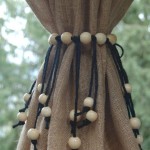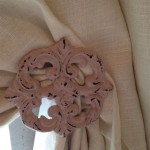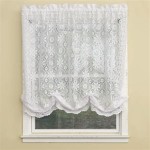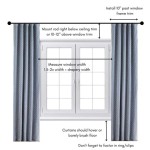White Curtains With Green Trim: A Comprehensive Guide
White curtains with green trim represent a versatile and aesthetically pleasing window treatment option, suitable for a wide range of interior design styles. The combination of a neutral white base with a natural green accent offers a balance of brightness and visual interest, creating a welcoming and refreshing atmosphere in any room. Understanding the various aspects of selecting, implementing, and maintaining these curtains is crucial for achieving the desired aesthetic and functionality.
The appeal of white curtains lies in their ability to maximize natural light and create a sense of spaciousness. White reflects light, making rooms appear brighter and larger. Furthermore, white serves as a neutral backdrop, allowing other elements in the room, such as furniture, artwork, and accessories, to take center stage. The addition of green trim introduces a subtle pop of color that is both calming and visually stimulating. Green, often associated with nature, promotes a sense of tranquility and well-being, making it an ideal choice for bedrooms, living rooms, and even home offices.
The design possibilities for white curtains with green trim are extensive. The trim can range from a delicate, thin border to a bold, wide band, depending on the desired impact. The shade of green can also vary, encompassing everything from soft, muted sage green to vibrant emerald green. The choice of fabric for both the curtain and the trim will further influence the overall look and feel of the curtains, affecting their light filtering properties, drape, and durability.
Key Considerations When Choosing White Curtains With Green Trim
Selecting the right white curtains with green trim requires careful consideration of several factors, including the room's existing decor, the desired level of light control, the functionality required, and the overall aesthetic goals. Overlooking these key points can lead to dissatisfaction with the final result. Here are some crucial aspects to consider:
Fabric Selection: The choice of fabric is paramount when selecting curtains. For white curtains, the opacity of the fabric will determine the amount of light that is allowed to filter through. Options range from sheer fabrics that allow maximum light penetration to heavier, opaque fabrics that provide greater privacy and light blocking capabilities. Linen, cotton, and polyester blends are common choices for white curtains, each offering different levels of durability, drape, and maintenance requirements. The trim fabric should complement the main curtain fabric in terms of texture and weight. For example, a cotton curtain might be paired with a cotton or linen trim, while a heavier polyester curtain may be better suited to a more substantial trim fabric.
Green Shade and Trim Width: The shade of green used for the trim and its width significantly impact the overall aesthetic. Lighter shades of green, such as mint or sage, create a more subtle and airy feel, while darker shades, such as forest green or emerald green, offer a bolder and more dramatic contrast. The width of the trim should be proportional to the size of the curtain and the room. A narrow trim is suitable for a more understated look, while a wider trim can make a stronger visual statement. It’s important to consider the existing color palette of the room when selecting the green shade. The trim should complement the wall color, furniture upholstery, and other decorative elements.
Curtain Style and Hanging Method: The style of the curtain and the hanging method can further enhance the aesthetic and functionality of the window treatment. Options include pleated curtains, grommet curtains, rod pocket curtains, and tab top curtains, each offering a different look and feel. Pleated curtains offer a more formal and tailored appearance, while grommet and tab top curtains have a more contemporary and casual vibe. The hanging method also affects the height and drape of the curtains. Hanging curtains closer to the ceiling can create the illusion of taller ceilings, while allowing the curtains to pool slightly on the floor can add a touch of elegance and drama.
Light Control and Privacy: The level of light control and privacy required should also be considered when selecting white curtains with green trim. If maximum light blocking is desired, opting for blackout curtains with a green trim is a viable option. Blackout curtains are made from a tightly woven fabric that prevents light from passing through, making them ideal for bedrooms or home theaters. For those who prefer to allow some natural light to filter through while still maintaining privacy, lined curtains or curtains made from a thicker, less transparent fabric are a good choice. The addition of a separate liner can also enhance the insulation properties of the curtains, helping to regulate room temperature and reduce energy consumption.
Room Aesthetics and Functionality: Consider the existing aesthetics of the room. In a minimalist or modern space, a simple white curtain with a thin, clean green trim would likely be more appropriate than a heavily patterned curtain with a wide, ornate trim. In a bohemian or eclectic space, a more textured fabric with a bolder green trim or even a patterned green trim could be a better fit. Functionality is another crucial consideration; are the curtains primarily decorative, or will they be used to block light, provide privacy, or insulate the room? The answer to this question will influence the choice of fabric, lining, and style of the curtains.
Integrating White Curtains With Green Trim Into Different Interior Design Styles
The versatility of white curtains with green trim allows them to be seamlessly integrated into various interior design styles, each achieving a unique and harmonious result. Understanding how to adapt the design elements of the curtains to complement the existing style is key to success.
Modern and Minimalist: In modern and minimalist spaces, simplicity is paramount. Opt for clean lines, minimal embellishments, and a neutral color palette. White curtains made from a lightweight, sheer fabric, such as voile or linen, with a thin, light green (such as mint or celadon) trim can enhance the airy and uncluttered feel of the room. Grommet or rod pocket curtains with a simple, straight hang are ideal. Avoid heavy fabrics, intricate patterns, or overly ornate details.
Traditional and Classic: For traditional and classic interiors, a more formal and sophisticated approach is appropriate. White curtains made from a heavier fabric, such as cotton or linen, with a medium-width, darker green (such as forest green or hunter green) trim can create a refined and elegant look. Pleated curtains, such as pinch pleat or goblet pleat, add a touch of formality. Consider adding a valance or cornice to further enhance the traditional aesthetic. The green trim can also feature subtle patterns or textures, such as a jacquard weave or a subtle floral motif.
Bohemian and Eclectic: Bohemian and eclectic styles embrace a more relaxed and unconventional aesthetic. White curtains made from a textured fabric, such as cotton slub or linen, with a bold, vibrant green (such as emerald green or lime green) trim can add a playful and energetic touch to the room. Consider using a patterned green trim with geometric or floral designs. Tab top or tie top curtains offer a more casual and relaxed look. Don't be afraid to mix and match different textures, patterns, and colors to create a unique and personalized space.
Coastal and Scandinavian: Coastal and Scandinavian styles emphasize light, airy, and natural elements. White curtains made from a lightweight, sheer fabric, such as linen or cotton voile, with a light, muted green (such as seafoam green or sage green) trim can enhance the breezy and relaxed feel of these spaces. Simple, unlined curtains with a rod pocket or tab top are ideal. The green trim can evoke the colors of the sea and the surrounding landscape. Avoid heavy fabrics or dark colors that can weigh down the space.
Farmhouse and Rustic: Farmhouse and rustic styles celebrate natural materials, cozy textures, and a sense of warmth. White curtains made from a heavier fabric, such as cotton or linen, with a medium-width, muted green (such as olive green or moss green) trim can complement the rustic charm of these spaces. Consider using a textured trim, such as burlap or linen, or adding details like ruffles or fringe. The green shade should evoke the colors of the countryside. Tie top or rod pocket curtains are a good choice for a more casual and homespun look.
Maintaining White Curtains With Green Trim
Proper maintenance is essential to preserving the beauty and longevity of white curtains with green trim. Regular cleaning and care will prevent dust, dirt, and stains from accumulating, ensuring that the curtains continue to look their best.
Regular Dusting and Vacuuming: The most basic maintenance step is regular dusting or vacuuming. Dust and dirt can settle on the curtains over time, dulling their appearance and potentially causing discoloration. Use a soft-bristled brush or a vacuum cleaner with a brush attachment to gently remove dust and debris from the curtains. Pay particular attention to the top and bottom edges, where dust tends to accumulate.
Washing or Dry Cleaning: Depending on the fabric and construction of the curtains, they may need to be washed or dry cleaned periodically. Always check the care label for specific instructions. Some fabrics, such as linen or delicate cotton, may require dry cleaning to prevent shrinkage or damage. Other fabrics, such as polyester blends, can typically be machine washed on a gentle cycle with cold water. Use a mild detergent and avoid using bleach, as it can damage the fabric and cause discoloration. If the curtains have a lining, it may need to be washed separately or dry cleaned.
Spot Cleaning: Address stains and spills as soon as possible to prevent them from setting. Use a clean, damp cloth and a mild detergent to gently blot the stain. Avoid rubbing, as this can spread the stain or damage the fabric. Test the cleaning solution on an inconspicuous area of the curtain first to ensure that it does not cause discoloration. For stubborn stains, consult a professional dry cleaner.
Ironing or Steaming: After washing or dry cleaning, the curtains may need to be ironed or steamed to remove wrinkles. Use a low heat setting and iron the curtains on the reverse side to prevent damage to the fabric. If steaming, use a garment steamer and hold it a few inches away from the fabric to avoid direct contact. Be particularly careful when ironing or steaming the green trim, as some fabrics may be more sensitive to heat than others.
Proper Storage: When storing curtains, ensure that they are clean and dry to prevent mildew or mold growth. Fold the curtains neatly and store them in a breathable bag or container. Avoid storing them in direct sunlight, as this can cause fading. If the curtains have a lining, store them with the lining facing inward to protect the fabric from damage.

Custom Curtains And Drapes With Grosgrain Ribbon Trim I Spiffy Spools

White Outdoor Curtains With Green Trim Design Ideas

White Outdoor Curtains With Green Trim Design Ideas

White Curtains With Green Trim Design Ideas

White Curtains With Green Trim Design Ideas

White Curtains With Green Trim Design Ideas

Blackout Ribbon Border Curtains Grosgrain W Color Options Trimmed Etsy

Cream White Cotton Linen Curtain Panels With Trim Beautiful Custom Curtains And Drapes Available In Extra Long Length Etsy Canada

Curtains With Kelly Green Trim Tape Trimmed Drapes Curtain Panels Ribbon

White Curtains With Green Ribbon Trim Design Ideas








